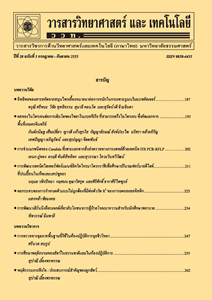การแยกแก๊สไฮโดรเจนจากแก๊สผสมด้วยเมมเบรนแพลเลเดียม
Main Article Content
Abstract
บทคัดย่อ
แก๊สไฮโดรเจนบริสุทธิ์มีบทบาทที่สำคัญในหลายอุตสาหกรรม โดยเฉพาะอุตสาหกรรมเซลล์เชื้อเพลิง เนื่องจากเป็นพลังงานสะอาด และมีศักยภาพสูงในการนำมาใช้เป็นพลังงานทดแทน แก๊สไฮโดรเจนสามารถผลิตได้จากกระบวนการทางเคมี แต่มีความบริสุทธิ์ไม่มากพอต่อการนำไปใช้ ดังนั้นกระบวนการแยกแก๊สไฮโดรเจนให้บริสุทธ์จึงเป็นสิ่งจำเป็นอย่างยิ่ง กระบวนการแยกด้วยเมมเบรนกำลังได้รับความสนใจอย่างมาก เนื่องจากเป็นกระบวนการที่มีประสิทธิภาพสูง การใช้งานง่ายและไม่ก่อให้เกิดผลเสียต่อสิ่งแวดล้อม แม้ว่าจากงานวิจัยที่ศึกษา พบว่าการแยกแก๊สไฮโดรเจนด้วยเมมเบรนความหนาแน่นสูงสามารถแยกแก๊สไฮโดรเจนได้ดีกว่าเมมเบรนแบบชนิดพอลิเมอร์และเมมเบรนแบบมีรูพรุน เมมเบรนความหนาแน่นสูงทั้งแบบเซรามิกและแบบโลหะให้ค่าเลือกผ่านของไฮโดรเจนค่อนข้างสูง แต่แบบโลหะให้ค่าไฮโดรเจนฟลักซ์ที่สูงกว่าแบบเซรามิก ถึงแม้เมมเบรนแพลเลเดียม (Pd) จะมีค่าการซึมผ่านน้อยกว่าเมมเบรนไนโอเบียม (Nb) วานาเดียม (Va) และแทนทาลัม (Ta) แต่แพลเลเดียมเมมเบรนไม่ก่อให้เกิดชั้นออกไซด์ขึ้นในขณะใช้งาน นอกจากนี้การเพิ่มประสิทธิภาพการแยกแก๊สไฮโดรเจนสามารถทำได้โดยการใช้โลหะผสมแพลเลเดียมเมมเบรน ค่าการซึมผ่านแก๊สไฮโดรเจนเพิ่มขึ้น 4.1 และ 2.3 เท่า เมื่อใช้โลหะยิทเทรียมและโลหะเงินผสม ตามลำดับ การเลือกเมมเบรนมาใช้งานจึงขึ้นกับความบริสุทธิ์ของไฮโดรเจนและสภาวะการใช้งานเป็นสำคัญ เมมเบรนโลหะสามารถผลิตไฮโดรเจนที่มีความบริสุทธิ์สูงแต่ค่าใช้จ่ายในการผลิตก็สูงเช่นเดียวกัน ในขณะที่เมมเบรนโพลิเมอร์จะมีค่าใช้จ่ายต่ำ
คำสำคัญ : การแยกแก๊สไฮโดรเจนบริสุทธิ์; เมมเบรนแพลเลเดียม; เมมเบรนโลหะผสมแพลเลเดียม; เซลเชื้อเพลิง
Abstract
High purity hydrogen is considered today as a promising clean fuel and a high potential renewable energy for the future, especially the hydrogen fuel cell industry. In practical, hydrogen can be produced from chemical reaction processes but its purity cannot be directly used in any aspects. Therefore, the separation process of hydrogen gas having high purity is essentially important. One of the most attractive separation processes is membrane separation. It is effective, effortless and environmentally-friendly technology. From the studied researches, it was found that hydrogen separation by dense membrane is the most effective for separating hydrogen comparing to polymeric membrane and porous membrane. Both ceramic and metallic dense membranes show high selectivity to hydrogen, but metallic membrane has higher hydrogen flux than ceramic membrane. Although palladium membrane has lower permeability than niobuim (Nb), vanadium (Va) and tantalum (Ta) but there is no oxide layer during the operation. Moreover, an increasing the efficiency can by developed by using palladium alloy membrane. The H2 permeability was increased to 4.1 and 2.3 times for palladium-yithrium alloy and palladium-silver alloy membranes, respectively. The selection of membrane highly depends on a purity of hydrogen and operating condition. Metallic membrane can produce high-purity hydrogen, but high cost of the production while polymeric membrane is low cost.
Keywords: pure hydrogen separation; palladium membrane; palladium alloys membrane; fuel cell


